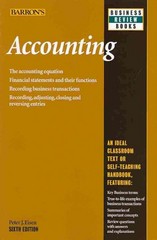Question
First, as a sole proprietor, A will pay $353046 in tax and have $646,954 left. Second, as a C corporation (or S corporation) paying out
First, as a sole proprietor, A will pay $353046 in tax and have $646,954 left.
Second, as a C corporation (or S corporation) paying out all net earnings as salary, the corporation will pay no income tax and thus theoretically could pay out the entire $1 million (disregarding employment taxes and local taxes), in which case A again will net $646,954. This, however, may not be possible or desirable, and part of such salary could be recharacterized as a dividend (but since 2003, taxation as a dividend is only 15 percent).
Third, if $500,000 is paid to A as salary, then A will net $344,954 (tax 155,046) on $500,000 income and the corporation will net $325,000 on $500,000 income (note that because this is a personal service corporation, the lower brackets are not available under 11(b)(2)). A can appropriate the retained earnings of $325,000 to his personal use by a dividend from which A will net $260,000 (tax at 20% 65,000), for a total net to A of $604,954, or by a sale of the stock, in which we assume A has nominal basis, for $325,000 resulting in a capital gains tax of $65,000 and a total net to A of $604,954. Thus, while A may be able to approximate his sole proprietorship result by using a C corporation paying out virtually all earnings in salary, an accumulation in X coupled with payment of the second-tier tax on that accumulation (even at the lower 20 percent) will result in the short term in a lower net return to A than if A had used a sole proprietorship. For the longer term, see question (2) B&E 1.02, 1.03, 5.01.
Discuss the lack of capital gain benefit for a C corporation taxpayer, and the limitation of use of capital losses. B&E 5.01.
An S election avoids double taxation of accumulated income and concern about having to pay salary equal to net earnings. Briefly discuss the following:
1. Eligibility for S election ( 1361(a) and 1361(b)).
2. Computation but nontaxability (normally) of income at the corporate level ( 1363(a) and 1363(b)).
3. Pass-through of income (here, $1 million) to A, if no salary is paid. Reasonable salary payments will help avoid a surprise assessment of employment taxes ( 1366(a) and 1366(b)) based on recharacterization of distributions as salary. Rev. Rul 74-44, 1974-1 CB 287.
4. Limitation on loss pass-through to basis in stock and debt 1366(d)(1)).
5. Increase in stock basis for S corporation income and decrease for distribution that is not included in shareholder's gross income. Here, if $1 million is distributed, then there is no change in stock basis whether the $1 million is paid as salary or on account of stock held; if $500,000 is paid as salary and $500,000 is retained, then $350,000 of tax is paid by A on the entire $1 million-half as salary and half as pass-through income-and there is $500,000 additional basis in stock, as that the remaining $500,000 may be distributed without additional tax ( 1367(a), 1367(b), 1368(a) and 1368(b)).
6. Fact that otherwise subchapter C rules apply ( 1371(a); B&E 6.01, 6.02, 6.06, 6.09).
Step by Step Solution
There are 3 Steps involved in it
Step: 1

Get Instant Access to Expert-Tailored Solutions
See step-by-step solutions with expert insights and AI powered tools for academic success
Step: 2

Step: 3

Ace Your Homework with AI
Get the answers you need in no time with our AI-driven, step-by-step assistance
Get Started


